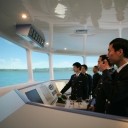第二章 机舱日常事务
1. Talk about the equipment in typical engine room
There are many machines and devices in the engine room. They are the main engine, generators, air compressors, oil separators, boilers, pumps, all kind of coolers, valves and so on. The main engine is the largest and most important machine. It is the ship’s power source. Our main engine is a slow-speed, two –stroke, crosshead type marine diesel engine. It consists of cylinder head, frame, bedplate and moving parts, etc. The type is MAN-B&W 6550MC with a capacity of 9550 Kw at 115 rpm. The prime mover of the generators is 6-cylinder, medium-speed, 4-stroke, trunk piston type marine diesel engine.
2. The main engine in our engine room
The main engine is the largest and most important machine in our engine room. It is a MAN-B&W 6550MC engine. It is a slow-speed 2-stroke crosshead type marine diesel engine. Its capacity is 9550kw at 115rpm. The main engine consists of many parts, such as piston, crosshead, connecting rod, crankshaft, cylinder cover, cylinder liner, bearing, bedplate and frame. To ensure the main engine in good working conditions, the engineers do a lot of maintenance work according to the instruction book such as keep the oil and water’s temperature and pressure at proper value at sea; inspect the crankcase at every port; take out, clean and lifting check the fuel injection valves; withdraw the piston then clean; renew the defective parts; open and clean the scavenging air trunk every 4-6 week; and so on. In a word, we do our best to keep the main engine in its good order.
3. Look at the illustration and say something about the marine diesel engine ( Fig.2-1)
1) Two-stroke, low speed, crosshead;
2) Moving parts: piston, crosshead, connecting rod, and crankshaft. Fixed parts: cylinder, stuffing box, frame, bedplate, etc.
3) Systems: cooling system, starting air system, and lubricating system. Etc.
4. Say something about the working cycle of the marine diesel engine.
1) The working cycle of the marine diesel engine includes four strokes. They are suction, compression, expansion and exhaust strokes.
2) The exhaust valve opened and the exhaust gas is expelled. The scavenge valve is opened and the charge fresh air is blown into the cylinder, removing the exhaust gas at the same time.
3) In the two-stroke engine, each revolution makes one power stroke, while in the four-stroke engine, it takes two revolutions to make one power stroke. The two-stroke engine can develop about twice the power of a four-stroke engine.
5. Say something about the exhaust gas turbocharger and supercharging.
1) The gas carbine and the compressor
2) Exhaust gas drives the turbine wheel that is coupled to the air compressor, so increase the density of fresh air
3) Increase the density of charged fresh air for combustion thus increasing the power output.
6. Say something about the cooling water system
There are two kinds of fresh water system: the closed system and the open system. The jacket cooling system is closed system. The piston cooling system is an open system. The jacket water, jacket cooling water pump, expansion tank, piston cooling water pump, cooling water tank.
7. Say something, about the removing of a piston.
1) Shut off starting air, engage turning gear, close cooling water valve.
2) Remove the cylinder cover, turn the piston to TDC, mount the special tool, dismount the piston rod bottom and with crosshead. Lift out the piston.
3) Check the piston crown, the piston ring and the su***ce of piston rod.
8. Say something about the control room.
1) There is a control stand, electric switchboard
2) From 0800am to 1600pm oiler, 1600pm to 0800am duty engineer.
3) When the alarm is sounded and engineer on duty must enter the engine room at once.
9. Say something about the modern UMS.
UMS are mainly unattended overnight and during this time, the bridge officer on watch should have control the main engine. From 0800 to 1600pm, the duty oiler in the engine room on watch. From 1600pm to 0800am the next day, the duty engineer is on watch in his cabin. In the event of alarm, the duty engineer must go to the engine room. UMS control room is highly automatic.
10. Talk about the compression refrigeration system according to the picture given.
This is a flow diagram of compression system. The important components are 1) coolant receiver 2) compressor 3) evaporator 4) condenser. The coolant flows from expansion valve to evaporator, and via it to compressor, then from compressor to condenser, aftmost to the coolant receiver.
11.Talk about the working principle of purifier according to the picture given.
The removal of impurities and water from fuel oil and lub oil is very important for the good working conditions of the engine. This is achieved by the centrifugal purifier. It consists of an electric motor drive to a vertical shaft on the top of which is mounted the bowl assembly. The high-speed rotation is a purifier can produce a centrifugal force many thousands times larger than the force of gravity. After the bowl fulfilled with clean water, the dirty oil is admitted into the center of the bowl, passes up through a stack discs and out through the top. During this process, the action of centrifugal force causes the clean oil to flow inwards and the water and impurities flow outwards. The water and impurities form a sludge, which moves outwards along the undersides of the discs to the periphery of the bowl. The excessive water will flow out through the water outlet and the sludge can be discharged at regular intervals. Thus, the whole process could be continuously.
12. Talk about the working principle of oily water separator according to the picture given.
Oily water separators are used to ensure that ships do not discharge oil when pumping out the bilge water, or oily water from oil tanks or any water contaminated space.
A complete oil/water separator is first filled with clean water; the oily water mixture is then pumped through the separator inlet pipe into the coarse separating compartment. Here some oil, as a result of its lower density, will separate and rise into the oil collection space. The remaining oil/water mixture now flows down into the fine separating compartment and moves slowly between the catch plates. More oil will separate out onto the underside of these plates and travel outwards until it is free to rise into the oil collecting space. The almost oil-free water passes into the central pipe and leaves the separator unit. When the oil collected in the top of separator reaches the desired level, then the second v/v will open to lead the oil out to a storage tank.
13. Talk about the anti-pollution equipment on board ship.
The anti-pollution equipment includes the oily water separator, incinerator, sewage treatment, they must be kept in good order; otherwise we would not pass the PSC inspection.
14. Talk about the operation of ballast system.
The ballast system is arranged to draw water from any tank or the sea and discharge it to any other tank or the sea. It is used to ballast or trim the vessel. When transferring ballast water from one tank to another, we must pay much attention. Open the related valves correctly. Close other valves and start the pump. Otherwise we could not pump the water. The last but is important, we must ask for the permission from the port authorities before discharge ballast water or we’ll be fined.
15.Talk about the operation of the bilge system
The bilge main is arranged to drain bilge from watertight compartment and machinery space. The bilge water from the bilge should be pumped to the bilge tank. Discharge of the bilge water overboard must pass through 15ppm oily water separator.
请登录后发帖

 联系我们人工客服
联系我们人工客服



















 :1391995811
:1391995811

